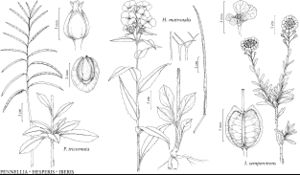Difference between revisions of "Iberis sempervirens"
Sp. Pl. 2: 648. 1753.
imported>Volume Importer |
imported>Volume Importer |
||
| Line 46: | Line 46: | ||
|publication year=1753 | |publication year=1753 | ||
|special status= | |special status= | ||
| − | |source xml=https:// | + | |source xml=https://bitbucket.org/aafc-mbb/fna-data-curation/src/2e0870ddd59836b60bcf96646a41e87ea5a5943a/coarse_grained_fna_xml/V7/V7_908.xml |
|tribe=Brassicaceae tribe Iberideae | |tribe=Brassicaceae tribe Iberideae | ||
|genus=Iberis | |genus=Iberis | ||
Latest revision as of 23:36, 5 November 2020
Perennials or subshrubs; (evergreen, with sterile shoots); glabrous. Stems decumbent, branched basally and distally, (0.5–)1–2.5 dm. Basal leaves (of sterile shoots) sessile; blade linear-oblanceolate, 1–3(–5) cm × 2–5 mm. Cauline leaves (of flowering shoots) similar to basal, blade smaller, margins entire. Racemes slightly elongated in fruit. Fruiting pedicels divaricate-ascending, 4–11 mm. Flowers: sepals oblong or ovate, 2–4 mm; petals white or sometimes pink, abaxial pair 5–13 × 2–7 mm, adaxial pair 3–6 × 1–3 mm. Fruits suborbicular to broadly ovate, 6–8 × 5–6 mm, apically notched; valves extending into subacute wing; style 1–3 mm, exserted beyond apical notch. Seeds narrowly winged, 2–3 mm. 2n = 22.
Phenology: Flowering Apr–Jul.
Habitat: Escape from cultivation, abandoned gardens
Distribution

Introduced; Calif., Mich., N.Y., s Europe, introduced also in South America.
Discussion
Selected References
None.
